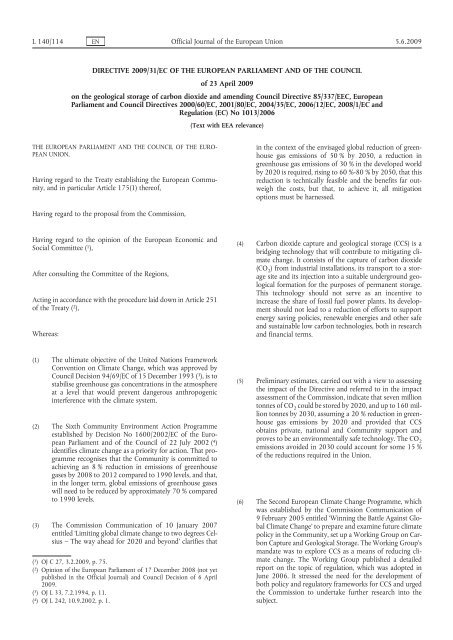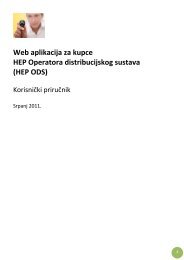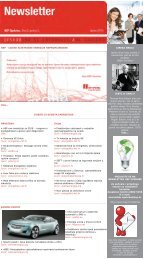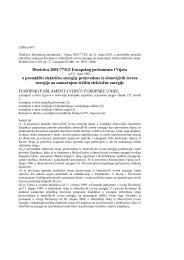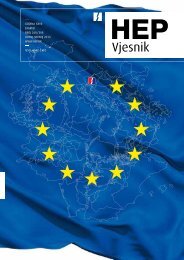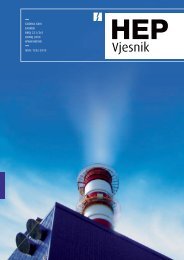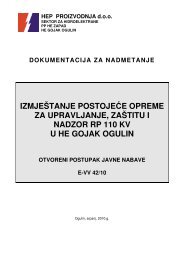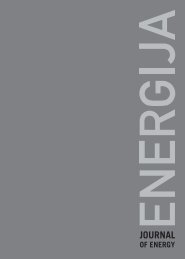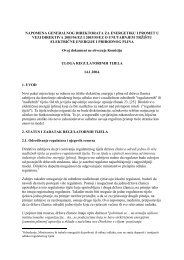Directive 2009/31/EC of the European Parliament and of ... - EUR-Lex
Directive 2009/31/EC of the European Parliament and of ... - EUR-Lex
Directive 2009/31/EC of the European Parliament and of ... - EUR-Lex
You also want an ePaper? Increase the reach of your titles
YUMPU automatically turns print PDFs into web optimized ePapers that Google loves.
L 140/114 EN Official Journal <strong>of</strong> <strong>the</strong> <strong>European</strong> Union 5.6.<strong>2009</strong>DIR<strong>EC</strong>TIVE <strong>2009</strong>/<strong>31</strong>/<strong>EC</strong> OF THE <strong>EUR</strong>OPEAN PARLIAMENT AND OF THE COUNCIL<strong>of</strong> 23 April <strong>2009</strong>on <strong>the</strong> geological storage <strong>of</strong> carbon dioxide <strong>and</strong> amending Council <strong>Directive</strong> 85/337/E<strong>EC</strong>, <strong>European</strong><strong>Parliament</strong> <strong>and</strong> Council <strong>Directive</strong>s 2000/60/<strong>EC</strong>, 2001/80/<strong>EC</strong>, 2004/35/<strong>EC</strong>, 2006/12/<strong>EC</strong>, 2008/1/<strong>EC</strong> <strong>and</strong>Regulation (<strong>EC</strong>) No 1013/2006(Text with EEA relevance)THE <strong>EUR</strong>OPEAN PARLIAMENT AND THE COUNCIL OF THE <strong>EUR</strong>OPEAN UNION,Having regard to <strong>the</strong> Treaty establishing <strong>the</strong> <strong>European</strong> Community,<strong>and</strong> in particular Article 175(1) <strong>the</strong>re<strong>of</strong>,in <strong>the</strong> context <strong>of</strong> <strong>the</strong> envisaged global reduction <strong>of</strong> greenhousegas emissions <strong>of</strong> 50 % by 2050, a reduction ingreenhouse gas emissions <strong>of</strong> 30 % in <strong>the</strong> developed worldby 2020 is required, rising to 60 %-80 % by 2050, that thisreduction is technically feasible <strong>and</strong> <strong>the</strong> benefits far outweigh<strong>the</strong> costs, but that, to achieve it, all mitigationoptions must be harnessed.Having regard to <strong>the</strong> proposal from <strong>the</strong> Commission,Having regard to <strong>the</strong> opinion <strong>of</strong> <strong>the</strong> <strong>European</strong> Economic <strong>and</strong>Social Committee ( 1 ),After consulting <strong>the</strong> Committee <strong>of</strong> <strong>the</strong> Regions,Acting in accordance with <strong>the</strong> procedure laid down in Article 251<strong>of</strong> <strong>the</strong> Treaty ( 2 ),Whereas:(4) Carbon dioxide capture <strong>and</strong> geological storage (CCS) is abridging technology that will contribute to mitigating climatechange. It consists <strong>of</strong> <strong>the</strong> capture <strong>of</strong> carbon dioxide(CO 2 ) from industrial installations, its transport to a storagesite <strong>and</strong> its injection into a suitable underground geologicalformation for <strong>the</strong> purposes <strong>of</strong> permanent storage.This technology should not serve as an incentive toincrease <strong>the</strong> share <strong>of</strong> fossil fuel power plants. Its developmentshould not lead to a reduction <strong>of</strong> efforts to supportenergy saving policies, renewable energies <strong>and</strong> o<strong>the</strong>r safe<strong>and</strong> sustainable low carbon technologies, both in research<strong>and</strong> financial terms.(1) The ultimate objective <strong>of</strong> <strong>the</strong> United Nations FrameworkConvention on Climate Change, which was approved byCouncil Decision 94/69/<strong>EC</strong> <strong>of</strong> 15 December 1993 ( 3 ), is tostabilise greenhouse gas concentrations in <strong>the</strong> atmosphereat a level that would prevent dangerous anthropogenicinterference with <strong>the</strong> climate system.(2) The Sixth Community Environment Action Programmeestablished by Decision No 1600/2002/<strong>EC</strong> <strong>of</strong> <strong>the</strong> <strong>European</strong><strong>Parliament</strong> <strong>and</strong> <strong>of</strong> <strong>the</strong> Council <strong>of</strong> 22 July 2002 ( 4 )identifies climate change as a priority for action. That programmerecognises that <strong>the</strong> Community is committed toachieving an 8 % reduction in emissions <strong>of</strong> greenhousegases by 2008 to 2012 compared to 1990 levels, <strong>and</strong> that,in <strong>the</strong> longer term, global emissions <strong>of</strong> greenhouse gaseswill need to be reduced by approximately 70 % comparedto 1990 levels.(3) The Commission Communication <strong>of</strong> 10 January 2007entitled ‘Limiting global climate change to two degrees Celsius– The way ahead for 2020 <strong>and</strong> beyond’ clarifies that( 1 ) OJ C 27, 3.2.<strong>2009</strong>, p. 75.( 2 ) Opinion <strong>of</strong> <strong>the</strong> <strong>European</strong> <strong>Parliament</strong> <strong>of</strong> 17 December 2008 (not yetpublished in <strong>the</strong> Official Journal) <strong>and</strong> Council Decision <strong>of</strong> 6 April<strong>2009</strong>.( 3 ) OJ L 33, 7.2.1994, p. 11.( 4 ) OJ L 242, 10.9.2002, p. 1.(5) Preliminary estimates, carried out with a view to assessing<strong>the</strong> impact <strong>of</strong> <strong>the</strong> <strong>Directive</strong> <strong>and</strong> referred to in <strong>the</strong> impactassessment <strong>of</strong> <strong>the</strong> Commission, indicate that seven milliontonnes <strong>of</strong> CO 2 could be stored by 2020, <strong>and</strong> up to 160 milliontonnes by 2030, assuming a 20 % reduction in greenhousegas emissions by 2020 <strong>and</strong> provided that CCSobtains private, national <strong>and</strong> Community support <strong>and</strong>proves to be an environmentally safe technology. The CO 2emissions avoided in 2030 could account for some 15 %<strong>of</strong> <strong>the</strong> reductions required in <strong>the</strong> Union.(6) The Second <strong>European</strong> Climate Change Programme, whichwas established by <strong>the</strong> Commission Communication <strong>of</strong>9 February 2005 entitled ‘Winning <strong>the</strong> Battle Against GlobalClimate Change’ to prepare <strong>and</strong> examine future climatepolicy in <strong>the</strong> Community, set up a Working Group on CarbonCapture <strong>and</strong> Geological Storage. The Working Group’sm<strong>and</strong>ate was to explore CCS as a means <strong>of</strong> reducing climatechange. The Working Group published a detailedreport on <strong>the</strong> topic <strong>of</strong> regulation, which was adopted inJune 2006. It stressed <strong>the</strong> need for <strong>the</strong> development <strong>of</strong>both policy <strong>and</strong> regulatory frameworks for CCS <strong>and</strong> urged<strong>the</strong> Commission to undertake fur<strong>the</strong>r research into <strong>the</strong>subject.
L 140/116 EN Official Journal <strong>of</strong> <strong>the</strong> <strong>European</strong> Union 5.6.<strong>2009</strong>(19) Member States should retain <strong>the</strong> right to determine <strong>the</strong>areas within <strong>the</strong>ir territory from which storage sites may beselected. This includes <strong>the</strong> right <strong>of</strong> Member States not toallow any storage in parts or on <strong>the</strong> whole <strong>of</strong> <strong>the</strong>ir territory,or to give priority to any o<strong>the</strong>r use <strong>of</strong> <strong>the</strong> underground,such as exploration, production <strong>and</strong> storage <strong>of</strong>hydrocarbons or geo<strong>the</strong>rmal use <strong>of</strong> aquifers. In this context,Member States should in particular give due considerationto o<strong>the</strong>r energy-related options for <strong>the</strong> use <strong>of</strong> apotential storage site, including options which are strategicfor <strong>the</strong> security <strong>of</strong> <strong>the</strong> Member State’s energy supply orfor <strong>the</strong> development <strong>of</strong> renewable sources <strong>of</strong> energy. Theselection <strong>of</strong> <strong>the</strong> appropriate storage site is crucial to ensurethat <strong>the</strong> stored CO 2 will be completely <strong>and</strong> permanentlycontained. Member States should, in selecting storage sites,take account <strong>of</strong> <strong>the</strong>ir geological characteristics, for exampleseismicity, in <strong>the</strong> most objective <strong>and</strong> effective way possible.A site should <strong>the</strong>refore only be selected as a storage site, if<strong>the</strong>re is no significant risk <strong>of</strong> leakage, <strong>and</strong> if in any case nosignificant environmental or health impacts are likely tooccur. This should be determined through a characterisation<strong>and</strong> assessment <strong>of</strong> a potential storage complex pursuantto specific requirements.(20) Enhanced Hydrocarbon Recovery (EHR) refers to <strong>the</strong>recovery <strong>of</strong> hydrocarbons in addition to those extracted bywater injection or o<strong>the</strong>r means. EHR is not in itself includedin <strong>the</strong> scope <strong>of</strong> this <strong>Directive</strong>. However, where EHR is combinedwith geological storage <strong>of</strong> CO 2 , <strong>the</strong> provisions <strong>of</strong> this<strong>Directive</strong> for <strong>the</strong> environmentally safe storage <strong>of</strong> CO 2should apply. In that case, <strong>the</strong> provisions <strong>of</strong> this <strong>Directive</strong>concerning leakage are not intended to apply to quantities<strong>of</strong> CO 2 released from surface installations which do notexceed what is necessary in <strong>the</strong> normal process <strong>of</strong> extraction<strong>of</strong> hydrocarbons, <strong>and</strong> which do not compromise <strong>the</strong>security <strong>of</strong> <strong>the</strong> geological storage or adversely affect <strong>the</strong>surrounding environment. Such releases are covered by <strong>the</strong>inclusion <strong>of</strong> storage sites in <strong>Directive</strong> 2003/87/<strong>EC</strong> <strong>of</strong> <strong>the</strong><strong>European</strong> <strong>Parliament</strong> <strong>and</strong> <strong>of</strong> <strong>the</strong> Council <strong>of</strong> 13 October2003 establishing a scheme for greenhouse gas emissionallowance trading within <strong>the</strong> Community ( 1 ), whichrequires surrender <strong>of</strong> emissions trading allowances for anyleaked emissions.<strong>the</strong> storage capacity available within <strong>the</strong>ir territory. TheCommission should organise an exchange <strong>of</strong> information<strong>and</strong> best practices between those Member States, in <strong>the</strong>context <strong>of</strong> <strong>the</strong> exchange <strong>of</strong> information provided for in this<strong>Directive</strong>.(23) Member States should determine in which cases explorationis required to generate <strong>the</strong> information necessary for<strong>the</strong> site selection. Exploration, that is activities intrudinginto <strong>the</strong> subsurface, should be made subject to a permitrequirement. Member States do not need to set admissioncriteria for procedures for granting exploration permits,but where <strong>the</strong>y do, <strong>the</strong>y should at least ensure that <strong>the</strong> proceduresfor <strong>the</strong> granting <strong>of</strong> exploration permits are open toall entities possessing <strong>the</strong> necessary capacities. MemberStates should also ensure that <strong>the</strong> permits are granted on<strong>the</strong> basis <strong>of</strong> objective, published <strong>and</strong> non-discriminatorycriteria. In order to protect <strong>and</strong> encourage explorationinvestments, exploration permits should be granted for alimited volume area <strong>and</strong> for a limited time during which<strong>the</strong> holder <strong>of</strong> <strong>the</strong> permit should have <strong>the</strong> sole right toexplore <strong>the</strong> potential CO 2 storage complex. Member Statesshould ensure that no conflicting uses <strong>of</strong> <strong>the</strong> complex arepermitted during this time. If no activities are carried outwithin a reasonable time, Member States should ensurethat <strong>the</strong> exploration permit is withdrawn <strong>and</strong> can begranted to o<strong>the</strong>r entities.(24) Storage sites should not be operated without a storage permit.The storage permit should be <strong>the</strong> core instrument toensure that <strong>the</strong> substantial requirements <strong>of</strong> this <strong>Directive</strong>are met <strong>and</strong> that geological storage <strong>the</strong>refore takes place inan environmentally safe way. In <strong>the</strong> granting <strong>of</strong> <strong>the</strong> storagepermit, priority should be given to <strong>the</strong> holder <strong>of</strong> <strong>the</strong>exploration permit over competitors, as <strong>the</strong> former willgenerally have made substantial investments.(21) Member States should make available to <strong>the</strong> public environmentalinformation relating to geological storage <strong>of</strong>CO 2 in accordance with applicable Community legislation.(22) Member States which intend to allow geological storage <strong>of</strong>CO 2 in <strong>the</strong>ir territory should undertake an assessment <strong>of</strong>( 1 ) OJ L 275, 25.10.2003, p. 32.(25) In <strong>the</strong> early phase <strong>of</strong> <strong>the</strong> implementation <strong>of</strong> this <strong>Directive</strong>,to ensure consistency in implementation <strong>of</strong> <strong>the</strong> requirements<strong>of</strong> this <strong>Directive</strong> across <strong>the</strong> Community, all storagepermit applications should be made available to <strong>the</strong> Commissionafter receipt. The draft storage permits should betransmitted to <strong>the</strong> Commission to enable it to issue anopinion on <strong>the</strong> draft permits within four months <strong>of</strong> <strong>the</strong>irreceipt. The national authorities should take this opinioninto consideration when taking a decision on <strong>the</strong> permit<strong>and</strong> should justify any departure from <strong>the</strong> Commission’sopinion. The review at Community level should also helpto enhance public confidence in CCS.
5.6.<strong>2009</strong> EN Official Journal <strong>of</strong> <strong>the</strong> <strong>European</strong> Union L 140/1232. Member States shall ensure that no substantial change isimplemented without a new or updated storage permit issued inaccordance with this <strong>Directive</strong>. Annex II, point 13, first indent <strong>of</strong><strong>Directive</strong> 85/337/E<strong>EC</strong> shall apply in such cases.3. The competent authority shall review <strong>and</strong> where necessaryupdate or, as a last resort, withdraw <strong>the</strong> storage permit:(a)if it has been notified or made aware <strong>of</strong> any leakages or significantirregularities pursuant to Article 16(1);(b) if <strong>the</strong> reports submitted pursuant to Article 14 or <strong>the</strong> environmentalinspections carried out pursuant to Article 15show non-compliance with permit conditions or risks <strong>of</strong>leakages or significant irregularities;(c)if it is aware <strong>of</strong> any o<strong>the</strong>r failure by <strong>the</strong> operator to meet <strong>the</strong>permit conditions;(d) if it appears necessary on <strong>the</strong> basis <strong>of</strong> <strong>the</strong> latest scientific findings<strong>and</strong> technological progress; oradded to assist in monitoring <strong>and</strong> verifying CO 2 migration. Concentrations<strong>of</strong> all incidental <strong>and</strong> added substances shall be belowlevels that would:(a)adversely affect <strong>the</strong> integrity <strong>of</strong> <strong>the</strong> storage site or <strong>the</strong> relevanttransport infrastructure;(b) pose a significant risk to <strong>the</strong> environment or human health;or(c) breach <strong>the</strong> requirements <strong>of</strong> applicable Communitylegislation.2. The Commission shall, if appropriate, adopt guidelines tohelp identify <strong>the</strong> conditions applicable on a case by case basis forrespecting <strong>the</strong> criteria laid down in paragraph 1.3. Member States shall ensure that <strong>the</strong> operator:(a)accepts <strong>and</strong> injects CO 2 streams only if an analysis <strong>of</strong> <strong>the</strong>composition, including corrosive substances, <strong>of</strong> <strong>the</strong> streams<strong>and</strong> a risk assessment have been carried out, <strong>and</strong> if <strong>the</strong> riskassessment has shown that <strong>the</strong> contamination levels are inline with <strong>the</strong> conditions referred to in paragraph 1;(e)without prejudice to points (a) to (d), five years after issuing<strong>the</strong> permit <strong>and</strong> every 10 years <strong>the</strong>reafter.(b) keeps a register <strong>of</strong> <strong>the</strong> quantities <strong>and</strong> properties <strong>of</strong> <strong>the</strong> CO 2streams delivered <strong>and</strong> injected, including <strong>the</strong> composition <strong>of</strong>those streams.4. After a permit has been withdrawn pursuant to paragraph 3,<strong>the</strong> competent authority shall ei<strong>the</strong>r issue a new storage permit orclose <strong>the</strong> storage site pursuant to Article 17(1)(c). Until a newstorage permit has been issued, <strong>the</strong> competent authority shalltemporarily take over all legal obligations relating to acceptancecriteria where <strong>the</strong> competent authority decides to continue CO 2injections, monitoring <strong>and</strong> corrective measures pursuant to <strong>the</strong>requirements laid down in this <strong>Directive</strong>, <strong>the</strong> surrender <strong>of</strong> allowancesin cases <strong>of</strong> leakage pursuant to <strong>Directive</strong> 2003/87/<strong>EC</strong> <strong>and</strong>preventive <strong>and</strong> remedial action pursuant to Articles 5(1) <strong>and</strong> 6(1)<strong>of</strong> <strong>Directive</strong> 2004/35/<strong>EC</strong>. The competent authority shall recoverany costs incurred from <strong>the</strong> former operator, including by drawingon <strong>the</strong> financial security referred to in Article 19. In case <strong>of</strong>closure <strong>of</strong> <strong>the</strong> storage site pursuant to Article 17(1)(c),Article 17(4) shall apply.CHAPTER 4OPERATION, CLOSURE AND POST-CLOSURE OBLIGATIONSArticle 12CO 2 stream acceptance criteria <strong>and</strong> procedure1. A CO 2 stream shall consist overwhelmingly <strong>of</strong> carbon dioxide.To this end, no waste or o<strong>the</strong>r matter may be added for <strong>the</strong>purpose <strong>of</strong> disposing <strong>of</strong> that waste or o<strong>the</strong>r matter. However, aCO 2 stream may contain incidental associated substances from<strong>the</strong> source, capture or injection process <strong>and</strong> trace substancesArticle 13Monitoring1. Member States shall ensure that <strong>the</strong> operator carries outmonitoring <strong>of</strong> <strong>the</strong> injection facilities, <strong>the</strong> storage complex (includingwhere possible <strong>the</strong> CO 2 plume), <strong>and</strong> where appropriate <strong>the</strong>surrounding environment for <strong>the</strong> purpose <strong>of</strong>:(a)comparison between <strong>the</strong> actual <strong>and</strong> modelled behaviour <strong>of</strong>CO 2 <strong>and</strong> formation water, in <strong>the</strong> storage site;(b) detecting significant irregularities;(c) detecting migration <strong>of</strong> CO 2 ;(d) detecting leakage <strong>of</strong> CO 2 ;(e)(f)detecting significant adverse effects for <strong>the</strong> surrounding environment,including in particular on drinking water, forhuman populations, or for users <strong>of</strong> <strong>the</strong> surroundingbiosphere;assessing <strong>the</strong> effectiveness <strong>of</strong> any corrective measures takenpursuant to Article 16;(g) updating <strong>the</strong> assessment <strong>of</strong> <strong>the</strong> safety <strong>and</strong> integrity <strong>of</strong> <strong>the</strong>storage complex in <strong>the</strong> short <strong>and</strong> long term, including <strong>the</strong>assessment <strong>of</strong> whe<strong>the</strong>r <strong>the</strong> stored CO 2 will be completely <strong>and</strong>permanently contained.
5.6.<strong>2009</strong> EN Official Journal <strong>of</strong> <strong>the</strong> <strong>European</strong> Union L 140/125Article 17Closure <strong>and</strong> post-closure obligationsArticle 18Transfer <strong>of</strong> responsibility1. A storage site shall be closed:(a)if <strong>the</strong> relevant conditions stated in <strong>the</strong> permit have been met;(b) at <strong>the</strong> substantiated request <strong>of</strong> <strong>the</strong> operator, after authorisation<strong>of</strong> <strong>the</strong> competent authority; or(c)if <strong>the</strong> competent authority so decides after <strong>the</strong> withdrawal <strong>of</strong>a storage permit pursuant to Article 11(3).2. After a storage site has been closed pursuant to points (a)or (b) <strong>of</strong> paragraph 1, <strong>the</strong> operator remains responsible for monitoring,reporting <strong>and</strong> corrective measures, pursuant to <strong>the</strong> requirementslaid down in this <strong>Directive</strong>, <strong>and</strong> for all obligations relatingto <strong>the</strong> surrender <strong>of</strong> allowances in case <strong>of</strong> leakages pursuant to<strong>Directive</strong> 2003/87/<strong>EC</strong> <strong>and</strong> preventive <strong>and</strong> remedial actions pursuantto Articles 5 to 8 <strong>of</strong> <strong>Directive</strong> 2004/35/<strong>EC</strong> until <strong>the</strong> responsibilityfor <strong>the</strong> storage site is transferred to <strong>the</strong> competentauthority pursuant to Article 18(1) to (5) <strong>of</strong> this <strong>Directive</strong>. Theoperator shall also be responsible for sealing <strong>the</strong> storage site <strong>and</strong>removing <strong>the</strong> injection facilities.3. The obligations referred to in paragraph 2 shall be fulfilledon <strong>the</strong> basis <strong>of</strong> a post-closure plan designed by <strong>the</strong> operator basedon best practice <strong>and</strong> in accordance with <strong>the</strong> requirements laiddown in Annex II. A provisional post-closure plan shall be submittedto <strong>and</strong> approved by <strong>the</strong> competent authority pursuant toArticle 7(8) <strong>and</strong> Article 9(7). Prior to <strong>the</strong> closure <strong>of</strong> a storage sitepursuant to points (a) or (b) <strong>of</strong> paragraph 1 <strong>of</strong> this Article, <strong>the</strong>provisional post-closure plan shall be:(a)updated as necessary, taking account <strong>of</strong> risk analysis, bestpractice <strong>and</strong> technological improvements;(b) submitted to <strong>the</strong> competent authority for its approval; <strong>and</strong>(c)approved by <strong>the</strong> competent authority as <strong>the</strong> definitive postclosureplan.4. After a storage site has been closed pursuant to paragraph1(c), <strong>the</strong> competent authority shall be responsible for monitoring<strong>and</strong> corrective measures pursuant to <strong>the</strong> requirements laiddown in this <strong>Directive</strong> <strong>and</strong> for all obligations relating to <strong>the</strong> surrender<strong>of</strong> allowances in case <strong>of</strong> leakages pursuant to <strong>Directive</strong>2003/87/<strong>EC</strong> <strong>and</strong> preventive <strong>and</strong> remedial action pursuant toArticles 5(1) <strong>and</strong> 6(1) <strong>of</strong> <strong>Directive</strong> 2004/35/<strong>EC</strong>. The post-closurerequirements pursuant to this <strong>Directive</strong> shall be fulfilled by <strong>the</strong>competent authority on <strong>the</strong> basis <strong>of</strong> <strong>the</strong> provisional post-closureplan referred to in paragraph 3 <strong>of</strong> this Article, which shall beupdated as necessary.5. The competent authority shall recover from <strong>the</strong> operator<strong>the</strong> costs incurred in relation to <strong>the</strong> measures referred to in paragraph4, including by drawing on <strong>the</strong> financial security pursuantto Article 19.1. Where a storage site has been closed pursuant to points (a)or (b) <strong>of</strong> Article 17(1), all legal obligations relating to monitoring<strong>and</strong> corrective measures pursuant to <strong>the</strong> requirements laid downin this <strong>Directive</strong>, <strong>the</strong> surrender <strong>of</strong> allowances in <strong>the</strong> event <strong>of</strong> leakagespursuant to <strong>Directive</strong> 2003/87/<strong>EC</strong> <strong>and</strong> preventive <strong>and</strong> remedialaction pursuant to Articles 5(1) <strong>and</strong> 6(1) <strong>of</strong> <strong>Directive</strong>2004/35/<strong>EC</strong>, shall be transferred to <strong>the</strong> competent authority onits own initiative or upon request from <strong>the</strong> operator, if <strong>the</strong> followingconditions are met:(a)all available evidence indicates that <strong>the</strong> stored CO 2 will becompletely <strong>and</strong> permanently contained;(b) a minimum period, to be determined by <strong>the</strong> competentauthority has elapsed. This minimum period shall be noshorter than 20 years, unless <strong>the</strong> competent authority is convincedthat <strong>the</strong> criterion referred to in point (a) is compliedwith before <strong>the</strong> end <strong>of</strong> that period;(c)<strong>the</strong> financial obligations referred to in Article 20 have beenfulfilled;(d) <strong>the</strong> site has been sealed <strong>and</strong> <strong>the</strong> injection facilities have beenremoved.2. The operator shall prepare a report documenting that <strong>the</strong>condition referred to in paragraph 1(a) has been met <strong>and</strong> shallsubmit it to <strong>the</strong> competent authority for <strong>the</strong> latter to approve <strong>the</strong>transfer <strong>of</strong> responsibility. This report shall demonstrate, at least:(a) <strong>the</strong> conformity <strong>of</strong> <strong>the</strong> actual behaviour <strong>of</strong> <strong>the</strong> injected CO 2with <strong>the</strong> modelled behaviour;(b) <strong>the</strong> absence <strong>of</strong> any detectable leakage;(c)that <strong>the</strong> storage site is evolving towards a situation <strong>of</strong> longtermstability.The Commission may adopt guidelines on <strong>the</strong> assessment <strong>of</strong> <strong>the</strong>matters referred to in points (a), (b) <strong>and</strong> (c) <strong>of</strong> <strong>the</strong> first subparagraph,highlighting <strong>the</strong>rein any implications for <strong>the</strong> technical criteriarelevant to <strong>the</strong> determination <strong>of</strong> <strong>the</strong> minimum periodsreferred to in paragraph 1(b).3. Where <strong>the</strong> competent authority is satisfied that <strong>the</strong> conditionsreferred to in points (a) <strong>and</strong> (b) <strong>of</strong> paragraph 1 are met, itshall prepare a draft decision <strong>of</strong> approval <strong>of</strong> <strong>the</strong> transfer <strong>of</strong> responsibility.The draft decision shall specify <strong>the</strong> method for determiningthat <strong>the</strong> conditions referred to in paragraph 1(d) have beenmet as well as any updated requirements for <strong>the</strong> sealing <strong>of</strong> <strong>the</strong>storage site <strong>and</strong> for <strong>the</strong> removal <strong>of</strong> injection facilities.If <strong>the</strong> competent authority considers that <strong>the</strong> conditions referredto in points (a) <strong>and</strong> (b) <strong>of</strong> paragraph 1 are not met, it shall inform<strong>the</strong> operator <strong>of</strong> its reasons.
L 140/126 EN Official Journal <strong>of</strong> <strong>the</strong> <strong>European</strong> Union 5.6.<strong>2009</strong>4. Member States shall make <strong>the</strong> reports referred to in paragraph2 available to <strong>the</strong> Commission within one month afterreceipt. They shall also make available o<strong>the</strong>r related material thatshall be taken into account by <strong>the</strong> competent authority when itprepares a draft decision <strong>of</strong> approval on <strong>the</strong> transfer <strong>of</strong> responsibility.They shall inform <strong>the</strong> Commission <strong>of</strong> all draft decisions <strong>of</strong>approval prepared by <strong>the</strong> competent authority pursuant to paragraph3, including any o<strong>the</strong>r material taken into consideration forarriving at its conclusion. Within four months after receipt <strong>of</strong> <strong>the</strong>draft decision <strong>of</strong> approval, <strong>the</strong> Commission may issue a nonbindingopinion on it. If <strong>the</strong> Commission decides not to issue anopinion, it shall inform <strong>the</strong> Member State within one month <strong>of</strong>submission <strong>of</strong> <strong>the</strong> draft decision <strong>of</strong> approval <strong>and</strong> state its reasons.5. Where <strong>the</strong> competent authority is satisfied that <strong>the</strong> conditionsreferred to in points (a) to (d) <strong>of</strong> paragraph 1 are compliedwith, it shall adopt <strong>the</strong> final decision <strong>and</strong> notify that decision to<strong>the</strong> operator. The competent authority shall also notify <strong>the</strong> finaldecision to <strong>the</strong> Commission, <strong>and</strong> where it departs from <strong>the</strong> Commissionopinion it shall state its reasons.6. After <strong>the</strong> transfer <strong>of</strong> responsibility, routine inspections providedfor in Article 15(3) shall cease <strong>and</strong> monitoring may bereduced to a level which allows for detection <strong>of</strong> leakages or significantirregularities. If any leakages or significant irregularitiesare detected, monitoring shall be intensified as required to assess<strong>the</strong> scale <strong>of</strong> <strong>the</strong> problem <strong>and</strong> <strong>the</strong> effectiveness <strong>of</strong> correctivemeasures.7. In cases where <strong>the</strong>re has been fault on <strong>the</strong> part <strong>of</strong> <strong>the</strong> operator,including cases <strong>of</strong> deficient data, concealment <strong>of</strong> relevantinformation, negligence, wilful deceit or a failure to exercise duediligence, <strong>the</strong> competent authority shall recover from <strong>the</strong> formeroperator <strong>the</strong> costs incurred after <strong>the</strong> transfer <strong>of</strong> responsibility hastaken place. Without prejudice to Article 20, <strong>the</strong>re shall be no fur<strong>the</strong>rrecovery <strong>of</strong> costs after <strong>the</strong> transfer <strong>of</strong> responsibility.8. Where a storage site has been closed pursuant toArticle 17(1)(c), transfer <strong>of</strong> responsibility shall be deemed to takeplace if <strong>and</strong> when all available evidence indicates that <strong>the</strong> storedCO 2 will be completely <strong>and</strong> permanently contained, <strong>and</strong> after <strong>the</strong>site has been sealed <strong>and</strong> <strong>the</strong> injection facilities have been removed.Article 19Financial security1. Member States shall ensure that pro<strong>of</strong> that adequate provisionscan be established, by way <strong>of</strong> financial security or any o<strong>the</strong>requivalent, on <strong>the</strong> basis <strong>of</strong> arrangements to be decided by <strong>the</strong>Member States, is presented by <strong>the</strong> potential operator as part <strong>of</strong><strong>the</strong> application for a storage permit. This is in order to ensure thatall obligations arising under <strong>the</strong> permit issued pursuant to this<strong>Directive</strong>, including closure <strong>and</strong> post-closure requirements, as wellas any obligations arising from inclusion <strong>of</strong> <strong>the</strong> storage site under<strong>Directive</strong> 2003/87/<strong>EC</strong>, can be met. This financial security shall bevalid <strong>and</strong> effective before commencement <strong>of</strong> injection.2. The financial security shall be periodically adjusted to takeaccount <strong>of</strong> changes to <strong>the</strong> assessed risk <strong>of</strong> leakage <strong>and</strong> <strong>the</strong> estimatedcosts <strong>of</strong> all obligations arising under <strong>the</strong> permit issued pursuantto this <strong>Directive</strong> as well as any obligations arising frominclusion <strong>of</strong> <strong>the</strong> storage site under <strong>Directive</strong> 2003/87/<strong>EC</strong>.3. The financial security or any o<strong>the</strong>r equivalent referred to inparagraph 1 shall remain valid <strong>and</strong> effective:(a)after a storage site has been closed pursuant to points (a)or (b) <strong>of</strong> Article 17(1), until <strong>the</strong> responsibility for <strong>the</strong> storagesite is transferred to <strong>the</strong> competent authority pursuant toArticle 18(1) to (5);(b) after <strong>the</strong> withdrawal <strong>of</strong> a storage permit pursuant toArticle 11(3):(i)until a new storage permit has been issued;(ii) where <strong>the</strong> site is closed pursuant to Article 17(1)(c), until<strong>the</strong> transfer <strong>of</strong> responsibility pursuant to Article 18(8),provided <strong>the</strong> financial obligations referred to inArticle 20 have been fulfilled.Article 20Financial mechanism1. Member States shall ensure that <strong>the</strong> operator, on <strong>the</strong> basis<strong>of</strong> arrangements to be decided by <strong>the</strong> Member States, makes afinancial contribution available to <strong>the</strong> competent authority before<strong>the</strong> transfer <strong>of</strong> responsibility pursuant to Article 18 has takenplace. The contribution from <strong>the</strong> operator shall take into accountthose criteria referred to in Annex I <strong>and</strong> elements relating to <strong>the</strong>history <strong>of</strong> storing CO 2 relevant to determining <strong>the</strong> post-transferobligations, <strong>and</strong> cover at least <strong>the</strong> anticipated cost <strong>of</strong> monitoringfor a period <strong>of</strong> 30 years. This financial contribution may be usedto cover <strong>the</strong> costs borne by <strong>the</strong> competent authority after <strong>the</strong>transfer <strong>of</strong> responsibility to ensure that <strong>the</strong> CO 2 is completely <strong>and</strong>permanently contained in geological storage sites after <strong>the</strong> transfer<strong>of</strong> responsibility.2. The Commission may adopt guidelines for <strong>the</strong> estimation <strong>of</strong><strong>the</strong> costs referred to in paragraph 1 to be developed in consultationwith Member States with a view to ensuring transparency<strong>and</strong> predictability for operators.CHAPTER 5THIRD-PARTY ACCESSArticle 21Access to transport network <strong>and</strong> storage sites1. Member States shall take <strong>the</strong> necessary measures to ensurethat potential users are able to obtain access to transport networks<strong>and</strong> to storage sites for <strong>the</strong> purposes <strong>of</strong> geological storage<strong>of</strong> <strong>the</strong> produced <strong>and</strong> captured CO 2 , in accordance with paragraphs2, 3 <strong>and</strong> 4.
5.6.<strong>2009</strong> EN Official Journal <strong>of</strong> <strong>the</strong> <strong>European</strong> Union L 140/1272. The access referred to in paragraph 1 shall be provided in atransparent <strong>and</strong> non-discriminatory manner determined by <strong>the</strong>Member State. The Member State shall apply <strong>the</strong> objectives <strong>of</strong> fair<strong>and</strong> open access, taking into account:(a)<strong>the</strong> storage capacity which is or can reasonably be madeavailable within <strong>the</strong> areas determined under Article 4, <strong>and</strong> <strong>the</strong>transport capacity which is or can reasonably be madeavailable;(b) <strong>the</strong> proportion <strong>of</strong> its CO 2 reduction obligations pursuant tointernational legal instruments <strong>and</strong> to Community legislationthat it intends to meet through capture <strong>and</strong> geological storage<strong>of</strong> CO 2 ;(c)<strong>the</strong> need to refuse access where <strong>the</strong>re is an incompatibility <strong>of</strong>technical specifications which cannot be reasonablyovercome;(d) <strong>the</strong> need to respect <strong>the</strong> duly substantiated reasonable needs<strong>of</strong> <strong>the</strong> owner or operator <strong>of</strong> <strong>the</strong> storage site or <strong>of</strong> <strong>the</strong> transportnetwork <strong>and</strong> <strong>the</strong> interests <strong>of</strong> all o<strong>the</strong>r users <strong>of</strong> <strong>the</strong> storageor <strong>the</strong> network or relevant processing or h<strong>and</strong>lingfacilities who may be affected.3. Transport network operators <strong>and</strong> operators <strong>of</strong> storage sitesmay refuse access on <strong>the</strong> grounds <strong>of</strong> lack <strong>of</strong> capacity. Duly substantiatedreasons shall be given for any refusal.4. Member States shall take <strong>the</strong> measures necessary to ensurethat <strong>the</strong> operator refusing access on <strong>the</strong> grounds <strong>of</strong> lack <strong>of</strong> capacityor a lack <strong>of</strong> connection makes any necessary enhancements asfar as it is economic to do so or when a potential customer is willingto pay for <strong>the</strong>m, provided this would not negatively impact on<strong>the</strong> environmental security <strong>of</strong> transport <strong>and</strong> geological storage <strong>of</strong>CO 2 .CHAPTER 6GENERAL PROVISIONSArticle 23Competent authorityMember States shall establish or designate <strong>the</strong> competent authorityor authorities responsible for fulfilling <strong>the</strong> duties establishedunder this <strong>Directive</strong>. Where more than one competent authorityis designated, Member States shall establish arrangements for <strong>the</strong>coordination <strong>of</strong> <strong>the</strong> work <strong>of</strong> those authorities undertaken pursuantto this <strong>Directive</strong>.Article 24Transboundary cooperationIn cases <strong>of</strong> transboundary transport <strong>of</strong> CO 2 , transboundary storagesites or transboundary storage complexes, <strong>the</strong> competentauthorities <strong>of</strong> <strong>the</strong> Member States concerned shall jointly meet <strong>the</strong>requirements <strong>of</strong> this <strong>Directive</strong> <strong>and</strong> <strong>of</strong> o<strong>the</strong>r relevant Communitylegislation.Article 25Registers1. The competent authority shall establish <strong>and</strong> maintain:(a)a register <strong>of</strong> <strong>the</strong> storage permits granted; <strong>and</strong>(b) a permanent register <strong>of</strong> all closed storage sites <strong>and</strong> surroundingstorage complexes, including maps <strong>and</strong> sections <strong>of</strong> <strong>the</strong>irspatial extent <strong>and</strong> available information relevant for assessingthat <strong>the</strong> stored CO 2 will be completely <strong>and</strong> permanentlycontained.2. The registers referred to in paragraph 1 shall be taken intoconsideration by <strong>the</strong> competent national authorities in relevantplanning procedures <strong>and</strong> when permitting any activity that couldaffect or be affected by <strong>the</strong> geological storage <strong>of</strong> CO 2 in <strong>the</strong> registeredstorage sites.Article 22Dispute settlement1. Member States shall ensure that <strong>the</strong>y have in place disputesettlement arrangements, including an authority independent <strong>of</strong><strong>the</strong> parties with access to all relevant information, to enable disputesrelating to access to transport networks <strong>and</strong> to storage sitesto be settled expeditiously, taking into account <strong>the</strong> criteria referredto in Article 21(2) <strong>and</strong> <strong>the</strong> number <strong>of</strong> parties which may beinvolved in negotiating such access.2. In <strong>the</strong> event <strong>of</strong> cross-border disputes, <strong>the</strong> dispute settlementarrangements <strong>of</strong> <strong>the</strong> Member State having jurisdiction over <strong>the</strong>transport network or <strong>the</strong> storage site to which access has beenrefused shall be applied. Where, in cross-border disputes, morethan one Member State covers <strong>the</strong> transport network or storagesite concerned, <strong>the</strong> Member States concerned shall consult with aview to ensuring that this <strong>Directive</strong> is applied consistently.Article 26Information to <strong>the</strong> publicMember States shall make available to <strong>the</strong> public environmentalinformation relating to <strong>the</strong> geological storage <strong>of</strong> CO 2 in accordancewith <strong>the</strong> applicable Community legislation.Article 27Reporting by Member States1. Every three years <strong>the</strong> Member States shall submit to <strong>the</strong>Commission a report on <strong>the</strong> implementation <strong>of</strong> this <strong>Directive</strong>,including <strong>the</strong> register referred to in Article 25(1)(b). The firstreport shall be sent to <strong>the</strong> Commission by 30 June 2011. Thereport shall be drawn up on <strong>the</strong> basis <strong>of</strong> a questionnaire or outlinedrafted by <strong>the</strong> Commission in accordance with <strong>the</strong> procedurereferred to in Article 6 <strong>of</strong> <strong>Directive</strong> 91/692/E<strong>EC</strong>. The questionnaireor outline shall be sent to Member States at least six monthsbefore <strong>the</strong> deadline for <strong>the</strong> submission <strong>of</strong> <strong>the</strong> report.
L 140/128 EN Official Journal <strong>of</strong> <strong>the</strong> <strong>European</strong> Union 5.6.<strong>2009</strong>2. The Commission shall organise an exchange <strong>of</strong> informationbetween <strong>the</strong> competent authorities <strong>of</strong> <strong>the</strong> Member States concerning<strong>the</strong> implementation <strong>of</strong> this <strong>Directive</strong>.Article 28PenaltiesThe Member States shall lay down <strong>the</strong> rules on penalties applicableto infringements <strong>of</strong> <strong>the</strong> national provisions adopted pursuantto this <strong>Directive</strong> <strong>and</strong> shall take all measures necessary toensure that <strong>the</strong>y are implemented. The penalties provided formust be effective, proportionate <strong>and</strong> dissuasive. The MemberStates shall notify those provisions to <strong>the</strong> Commission by 25 June2011 <strong>and</strong> shall notify it without delay <strong>of</strong> any subsequent amendmentaffecting <strong>the</strong>m.Article 29Amendments <strong>of</strong> AnnexesMeasures may be adopted to amend <strong>the</strong> Annexes. Those measures,designed to amend non-essential elements <strong>of</strong> this <strong>Directive</strong>,shall be adopted in accordance with <strong>the</strong> regulatory procedurewith scrutiny referred to in Article 30(2).Article 30Committee procedure1. The Commission shall be assisted by <strong>the</strong> Climate ChangeCommittee.2. Where reference is made to this paragraph, Article 5a(1)to (4) <strong>and</strong> Article 7 <strong>of</strong> Decision 1999/468/<strong>EC</strong> shall apply, havingregard to <strong>the</strong> provisions <strong>of</strong> Article 8 <strong>the</strong>re<strong>of</strong>.CHAPTER 7AMENDMENTSArticle <strong>31</strong>Amendment <strong>of</strong> <strong>Directive</strong> 85/337/E<strong>EC</strong><strong>Directive</strong> 85/337/E<strong>EC</strong> is hereby amended as follows:1. Annex I shall be amended as follows:24. Installations for <strong>the</strong> capture <strong>of</strong> CO 2 streams for <strong>the</strong>purposes <strong>of</strong> geological storage pursuant to <strong>Directive</strong><strong>2009</strong>/<strong>31</strong>/<strong>EC</strong> from installations covered by thisAnnex, or where <strong>the</strong> total yearly capture <strong>of</strong> CO 2 is1,5 megatonnes or more.( * ) OJ L 140, 5.6.<strong>2009</strong>, p. 114.’;2. Annex II shall be amended as follows:(a) <strong>the</strong> following point shall be added to point 3:‘(j)Installations for <strong>the</strong> capture <strong>of</strong> CO 2 streams for <strong>the</strong>purposes <strong>of</strong> geological storage pursuant to <strong>Directive</strong><strong>2009</strong>/<strong>31</strong>/<strong>EC</strong> from installations not covered byAnnex I to this <strong>Directive</strong>.’;(b) point (i) <strong>of</strong> point 10 shall be replaced by <strong>the</strong> following:‘(i)Oil <strong>and</strong> gas pipeline installations <strong>and</strong> pipelines for<strong>the</strong> transport <strong>of</strong> CO 2 streams for <strong>the</strong> purposes <strong>of</strong>geological storage (projects not included inAnnex I).’Article 32Amendment <strong>of</strong> <strong>Directive</strong> 2000/60/<strong>EC</strong>In Article 11(3)(j) <strong>of</strong> <strong>Directive</strong> 2000/60/<strong>EC</strong>, <strong>the</strong> following indentshall be inserted after <strong>the</strong> third indent:‘— injection <strong>of</strong> carbon dioxide streams for storage purposes intogeological formations which for natural reasons are permanentlyunsuitable for o<strong>the</strong>r purposes, provided that suchinjection is made in accordance with <strong>Directive</strong> <strong>2009</strong>/<strong>31</strong>/<strong>EC</strong><strong>of</strong> <strong>the</strong> <strong>European</strong> <strong>Parliament</strong> <strong>and</strong> <strong>of</strong> <strong>the</strong> Council <strong>of</strong> 23 April<strong>2009</strong> on <strong>the</strong> geological storage <strong>of</strong> carbon dioxide ( * ) orexcluded from <strong>the</strong> scope <strong>of</strong> that <strong>Directive</strong> pursuant to itsArticle 2(2);( * ) OJ L 140, 5.6.<strong>2009</strong>, p. 114.’Article 33Amendment <strong>of</strong> <strong>Directive</strong> 2001/80/<strong>EC</strong>(a)point 16 shall be replaced by <strong>the</strong> following:In <strong>Directive</strong> 2001/80/<strong>EC</strong>, <strong>the</strong> following Article shall be inserted:‘16. Pipelines with a diameter <strong>of</strong> more than 800 mm<strong>and</strong> a length <strong>of</strong> more than 40 km:— for <strong>the</strong> transport <strong>of</strong> gas, oil, chemicals, <strong>and</strong>,— for <strong>the</strong> transport <strong>of</strong> carbon dioxide (CO 2 )streams for <strong>the</strong> purposes <strong>of</strong> geological storage,including associated booster stations.’;(b) <strong>the</strong> following points shall be added:‘23. Storage sites pursuant to <strong>Directive</strong> <strong>2009</strong>/<strong>31</strong>/<strong>EC</strong> <strong>of</strong><strong>the</strong> <strong>European</strong> <strong>Parliament</strong> <strong>and</strong> <strong>of</strong> <strong>the</strong> Council <strong>of</strong>23 April <strong>2009</strong> on <strong>the</strong> geological storage <strong>of</strong> carbondioxide ( * ).‘Article 9a1. Member States shall ensure that operators <strong>of</strong> all combustionplants with a rated electrical output <strong>of</strong> 300 megawatts or morefor which <strong>the</strong> original construction licence or, in <strong>the</strong> absence <strong>of</strong>such a procedure, <strong>the</strong> original operating licence is granted after<strong>the</strong> entry into force <strong>of</strong> <strong>Directive</strong> <strong>2009</strong>/<strong>31</strong>/<strong>EC</strong> <strong>of</strong> <strong>the</strong> <strong>European</strong> <strong>Parliament</strong><strong>and</strong> <strong>of</strong> <strong>the</strong> Council <strong>of</strong> 23 April <strong>2009</strong> on <strong>the</strong> geologicalstorage <strong>of</strong> carbon dioxide ( * ), have assessed whe<strong>the</strong>r <strong>the</strong> followingconditions are met:— suitable storage sites are available,
5.6.<strong>2009</strong> EN Official Journal <strong>of</strong> <strong>the</strong> <strong>European</strong> Union L 140/129— transport facilities are technically <strong>and</strong> economically feasible,— it is technically <strong>and</strong> economically feasible to retr<strong>of</strong>it for CO 2capture.2. If <strong>the</strong> conditions in paragraph 1 are met, <strong>the</strong> competentauthority shall ensure that suitable space on <strong>the</strong> installation sitefor <strong>the</strong> equipment necessary to capture <strong>and</strong> compress CO 2 is setaside. The competent authority shall determine whe<strong>the</strong>r <strong>the</strong> conditionsare met on <strong>the</strong> basis <strong>of</strong> <strong>the</strong> assessment referred to in paragraph1 <strong>and</strong> o<strong>the</strong>r available information, particularly concerning<strong>the</strong> protection <strong>of</strong> <strong>the</strong> environment <strong>and</strong> human health.( * ) OJ L 140, 5.6.<strong>2009</strong>, p. 114.’Article 37Amendment <strong>of</strong> <strong>Directive</strong> 2008/1/<strong>EC</strong>In Annex I to <strong>Directive</strong> 2008/1/<strong>EC</strong>, <strong>the</strong> following point shall beadded:‘6.9. Capture <strong>of</strong> CO 2 streams from installations covered by this<strong>Directive</strong> for <strong>the</strong> purposes <strong>of</strong> geological storage pursuant to<strong>Directive</strong> <strong>2009</strong>/<strong>31</strong>/<strong>EC</strong> <strong>of</strong> <strong>the</strong> <strong>European</strong> <strong>Parliament</strong> <strong>and</strong> <strong>of</strong><strong>the</strong> Council <strong>of</strong> 23 April <strong>2009</strong> on <strong>the</strong> geological storage <strong>of</strong>carbon dioxide ( * ).( * ) OJ L 140, 5.6.<strong>2009</strong>, p. 114.’Article 34Amendment <strong>of</strong> <strong>Directive</strong> 2004/35/<strong>EC</strong>In Annex III to <strong>Directive</strong> 2004/35/<strong>EC</strong>, <strong>the</strong> following paragraphshall be added:‘14. The operation <strong>of</strong> storage sites pursuant to <strong>Directive</strong><strong>2009</strong>/<strong>31</strong>/<strong>EC</strong> <strong>of</strong> <strong>the</strong> <strong>European</strong> <strong>Parliament</strong> <strong>and</strong> <strong>of</strong> <strong>the</strong> Council<strong>of</strong> 23 April <strong>2009</strong> on <strong>the</strong> geological storage <strong>of</strong> carbondioxide ( * );( * ) OJ L 140, 5.6.<strong>2009</strong>, p. 114.’Article 35Amendment <strong>of</strong> <strong>Directive</strong> 2006/12/<strong>EC</strong>Article 2(1)(a) <strong>of</strong> <strong>Directive</strong> 2006/12/<strong>EC</strong> shall be replaced by <strong>the</strong>following:‘(a) gaseous effluents emitted into <strong>the</strong> atmosphere <strong>and</strong> carbondioxide captured <strong>and</strong> transported for <strong>the</strong> purposes <strong>of</strong> geologicalstorage <strong>and</strong> geologically stored in accordance with<strong>Directive</strong> <strong>2009</strong>/<strong>31</strong>/<strong>EC</strong> <strong>of</strong> <strong>the</strong> <strong>European</strong> <strong>Parliament</strong> <strong>and</strong> <strong>of</strong> <strong>the</strong>Council <strong>of</strong> 23 April <strong>2009</strong> on <strong>the</strong> geological storage <strong>of</strong> carbondioxide ( * ) or excluded from <strong>the</strong> scope <strong>of</strong> that <strong>Directive</strong>pursuant to its Article 2(2);( * ) OJ L 140, 5.6.<strong>2009</strong>, p. 114.’Article 36Amendment <strong>of</strong> Regulation (<strong>EC</strong>) No 1013/2006In Article 1(3) <strong>of</strong> Regulation (<strong>EC</strong>) No 1013/2006, <strong>the</strong> followingpoint shall be added:‘(h) shipments <strong>of</strong> CO 2 for <strong>the</strong> purposes <strong>of</strong> geological storage inaccordance with <strong>Directive</strong> <strong>2009</strong>/<strong>31</strong>/<strong>EC</strong> <strong>of</strong> <strong>the</strong> <strong>European</strong> <strong>Parliament</strong><strong>and</strong> <strong>of</strong> <strong>the</strong> Council <strong>of</strong> 23 April <strong>2009</strong> on <strong>the</strong> geologicalstorage <strong>of</strong> carbon dioxide ( * );( * ) OJ L 140, 5.6.<strong>2009</strong>, p. 114.’CHAPTER 8FINAL PROVISIONSArticle 38Review1. The Commission shall transmit to <strong>the</strong> <strong>European</strong> <strong>Parliament</strong><strong>and</strong> to <strong>the</strong> Council a report on <strong>the</strong> implementation <strong>of</strong> this <strong>Directive</strong>within nine months <strong>of</strong> receiving <strong>the</strong> reports referred to inArticle 27.2. In <strong>the</strong> report transmitted by <strong>31</strong> March 2015, <strong>the</strong> Commissionshall assess in particular, on <strong>the</strong> basis <strong>of</strong> experience with <strong>the</strong>implementation <strong>of</strong> this <strong>Directive</strong>, in light <strong>of</strong> <strong>the</strong> experience withCCS <strong>and</strong> taking into account technical progress <strong>and</strong> <strong>the</strong> mostrecent scientific knowledge:— whe<strong>the</strong>r permanent containment <strong>of</strong> CO 2 in such a way as toprevent <strong>and</strong> reduce as far as possible negative effects on <strong>the</strong>environment <strong>and</strong> any resulting risk to human health <strong>and</strong> <strong>the</strong>environmental <strong>and</strong> human safety <strong>of</strong> CCS has been sufficientlydemonstrated,— whe<strong>the</strong>r <strong>the</strong> procedures regarding <strong>the</strong> Commission’s reviews<strong>of</strong> <strong>the</strong> draft storage permits, referred to in Article 10, <strong>and</strong> <strong>the</strong>draft decisions on transfer <strong>of</strong> responsibility, referred to inArticle 18, are still required,— experience with <strong>the</strong> provisions on CO 2 stream acceptancecriteria <strong>and</strong> procedure referred to in Article 12,— experience with <strong>the</strong> provisions on third-party access referredto in Articles 21 <strong>and</strong> 22 <strong>and</strong> with <strong>the</strong> provisions on transboundarycooperation pursuant to Article 24,— <strong>the</strong> provisions applicable to combustion plants with a ratedelectrical output <strong>of</strong> 300 megawatts or more referred to inArticle 9a <strong>of</strong> <strong>Directive</strong> 2001/80/<strong>EC</strong>,— prospects for geological storage <strong>of</strong> CO 2 in third countries,— fur<strong>the</strong>r development <strong>and</strong> updating <strong>of</strong> <strong>the</strong> criteria referred toin Annex I <strong>and</strong> Annex II,
L 140/130 EN Official Journal <strong>of</strong> <strong>the</strong> <strong>European</strong> Union 5.6.<strong>2009</strong>— experience with incentives for applying CCS on installationscombusting biomass,— <strong>the</strong> need for fur<strong>the</strong>r regulation on environmental risks relatedto CO 2 transport,<strong>and</strong> shall present a proposal for revision <strong>of</strong> <strong>the</strong> <strong>Directive</strong> ifappropriate.3. Where permanent containment <strong>of</strong> CO 2 in such way as toprevent <strong>and</strong>, where this is not possible, eliminate as far as possiblenegative effects <strong>and</strong> any risk to <strong>the</strong> environment <strong>and</strong> humanhealth, <strong>and</strong> <strong>the</strong> environmental <strong>and</strong> human safety <strong>of</strong> CCS havebeen sufficiently demonstrated, as well as its economic feasibility,<strong>the</strong> review shall examine whe<strong>the</strong>r it is needed <strong>and</strong> practicable toestablish a m<strong>and</strong>atory requirement for emission performancest<strong>and</strong>ards for new electricity-generating large combustion installationspursuant to Article 9a <strong>of</strong> <strong>Directive</strong> 2001/80/<strong>EC</strong>.Article 39Transposition <strong>and</strong> transitional measures1. Member States shall bring into force <strong>the</strong> laws, regulations<strong>and</strong> administrative provisions necessary to comply with this<strong>Directive</strong> by 25 June 2011. They shall forthwith communicate to<strong>the</strong> Commission <strong>the</strong> text <strong>of</strong> those measures.3. Member States shall ensure that <strong>the</strong> following storage sitesfalling within <strong>the</strong> scope <strong>of</strong> this <strong>Directive</strong> are operated in accordancewith <strong>the</strong> requirements <strong>of</strong> this <strong>Directive</strong> by 25 June 2012:(a)storage sites used in accordance with existing legislation on25 June <strong>2009</strong>;(b) storage sites authorised in accordance with such legislationbefore or on 25 June <strong>2009</strong>, provided that <strong>the</strong> sites are usednot later than one year after that date.Articles 4 <strong>and</strong> 5, Article 7(3), Article 8(2) <strong>and</strong> Article 10 shall notapply in <strong>the</strong>se cases.Article 40Entry into forceThis <strong>Directive</strong> shall enter into force on <strong>the</strong> 20th day following itspublication in <strong>the</strong> Official Journal <strong>of</strong> <strong>the</strong> <strong>European</strong> Union.Article 41AddresseesThis <strong>Directive</strong> is addressed to <strong>the</strong> Member States.When Member States adopt <strong>the</strong>se measures, <strong>the</strong>y shall contain areference to this <strong>Directive</strong> or shall be accompanied by such referenceon <strong>the</strong> occasion <strong>of</strong> <strong>the</strong>ir <strong>of</strong>ficial publication. The methods <strong>of</strong>making such reference shall be laid down by Member States.2. Member States shall communicate to <strong>the</strong> Commission <strong>the</strong>text <strong>of</strong> <strong>the</strong> main provisions <strong>of</strong> national law which <strong>the</strong>y adopt in<strong>the</strong> field covered by this <strong>Directive</strong>.Done at Strasbourg, 23 April <strong>2009</strong>.For <strong>the</strong> <strong>European</strong> <strong>Parliament</strong>The PresidentH.-G. PÖTTERINGFor <strong>the</strong> CouncilThe PresidentP. NEČAS
5.6.<strong>2009</strong> EN Official Journal <strong>of</strong> <strong>the</strong> <strong>European</strong> Union L 140/1<strong>31</strong>ANNEX ICRITERIA FOR THE CHARACTERISATION AND ASSESSMENT OF THE POTENTIAL STORAGE COMPLEXAND SURROUNDING AREA REFERRED TO IN ARTICLE 4(3)The characterisation <strong>and</strong> assessment <strong>of</strong> <strong>the</strong> potential storage complex <strong>and</strong> surrounding area referred to in Article 4(3) shallbe carried out in three steps according to best practices at <strong>the</strong> time <strong>of</strong> <strong>the</strong> assessment <strong>and</strong> to <strong>the</strong> following criteria. Derogationsfrom one or more <strong>of</strong> <strong>the</strong>se criteria may be permitted by <strong>the</strong> competent authority provided <strong>the</strong> operator has demonstratedthat <strong>the</strong> capacity <strong>of</strong> <strong>the</strong> characterisation <strong>and</strong> assessment to enable <strong>the</strong> determinations pursuant to Article 4 is notaffected.Step 1:Data collectionSufficient data shall be accumulated to construct a volumetric <strong>and</strong> three-dimensional static (3-D)-earth model for <strong>the</strong> storagesite <strong>and</strong> storage complex, including <strong>the</strong> caprock, <strong>and</strong> <strong>the</strong> surrounding area, including <strong>the</strong> hydraulically connected areas.This data shall cover at least <strong>the</strong> following intrinsic characteristics <strong>of</strong> <strong>the</strong> storage complex:(a)(b)(c)(d)(e)(f)(g)geology <strong>and</strong> geophysics;hydrogeology (in particular existence <strong>of</strong> ground water intended for consumption);reservoir engineering (including volumetric calculations <strong>of</strong> pore volume for CO 2 injection <strong>and</strong> ultimate storagecapacity);geochemistry (dissolution rates, mineralisation rates);geomechanics (permeability, fracture pressure);seismicity;presence <strong>and</strong> condition <strong>of</strong> natural <strong>and</strong> man-made pathways, including wells <strong>and</strong> boreholes which could provide leakagepathways.The following characteristics <strong>of</strong> <strong>the</strong> complex vicinity shall be documented:(h)(i)(j)(k)(l)domains surrounding <strong>the</strong> storage complex that may be affected by <strong>the</strong> storage <strong>of</strong> CO 2 in <strong>the</strong> storage site;population distribution in <strong>the</strong> region overlying <strong>the</strong> storage site;proximity to valuable natural resources (including in particular Natura 2000 areas pursuant to Council <strong>Directive</strong>79/409/E<strong>EC</strong> <strong>of</strong> 2 April 1979 on <strong>the</strong> conservation <strong>of</strong> wild birds ( 1 ) <strong>and</strong> Council <strong>Directive</strong> 92/43/E<strong>EC</strong> <strong>of</strong> 21 May 1992on <strong>the</strong> conservation <strong>of</strong> natural habitats <strong>and</strong> <strong>of</strong> wild fauna <strong>and</strong> flora ( 2 ), potable groundwater <strong>and</strong> hydrocarbons);activities around <strong>the</strong> storage complex <strong>and</strong> possible interactions with <strong>the</strong>se activities (for example, exploration, production<strong>and</strong> storage <strong>of</strong> hydrocarbons, geo<strong>the</strong>rmal use <strong>of</strong> aquifers <strong>and</strong> use <strong>of</strong> underground water reserves);proximity to <strong>the</strong> potential CO 2 source(s) (including estimates <strong>of</strong> <strong>the</strong> total potential mass <strong>of</strong> CO 2 economically availablefor storage) <strong>and</strong> adequate transport networks.Step 2:Building <strong>the</strong> three-dimensional static geological earth modelUsing <strong>the</strong> data collected in Step 1, a three-dimensional static geological earth model, or a set <strong>of</strong> such models, <strong>of</strong> <strong>the</strong> c<strong>and</strong>idatestorage complex, including <strong>the</strong> caprock <strong>and</strong> <strong>the</strong> hydraulically connected areas <strong>and</strong> fluids shall be built using computerreservoir simulators. The static geological earth model(s) shall characterise <strong>the</strong> complex in terms <strong>of</strong>:(a)geological structure <strong>of</strong> <strong>the</strong> physical trap;(b)geomechanical, geochemical <strong>and</strong> flow properties <strong>of</strong> <strong>the</strong> reservoir overburden (caprock, seals, porous <strong>and</strong> permeablehorizons) <strong>and</strong> surrounding formations;( 1 ) OJ L 103, 25.4.1979, p. 1.( 2 ) OJ L 206, 22.7.1992, p. 7.
L 140/132 EN Official Journal <strong>of</strong> <strong>the</strong> <strong>European</strong> Union 5.6.<strong>2009</strong>(c)(d)(e)(f)(g)fracture system characterisation <strong>and</strong> presence <strong>of</strong> any human-made pathways;areal <strong>and</strong> vertical extent <strong>of</strong> <strong>the</strong> storage complex;pore space volume (including porosity distribution);baseline fluid distribution;any o<strong>the</strong>r relevant characteristics.The uncertainty associated with each <strong>of</strong> <strong>the</strong> parameters used to build <strong>the</strong> model shall be assessed by developing a range <strong>of</strong>scenarios for each parameter <strong>and</strong> calculating <strong>the</strong> appropriate confidence limits. Any uncertainty associated with <strong>the</strong> modelitself shall also be assessed.Step 3:Characterisation <strong>of</strong> <strong>the</strong> storage dynamic behaviour, sensitivity characterisation, risk assessmentThe characterisations <strong>and</strong> assessment shall be based on dynamic modelling, comprising a variety <strong>of</strong> time-step simulations <strong>of</strong>CO 2 injection into <strong>the</strong> storage site using <strong>the</strong> three-dimensional static geological earth model(s) in <strong>the</strong> computerised storagecomplex simulator constructed under Step 2.Step 3.1: Characterisation <strong>of</strong> <strong>the</strong> storage dynamic behaviourAt least <strong>the</strong> following factors shall be considered:(a)(b)(c)(d)(e)possible injection rates <strong>and</strong> CO 2 stream properties;<strong>the</strong> efficacy <strong>of</strong> coupled process modelling (that is, <strong>the</strong> way various single effects in <strong>the</strong> simulator(s) interact);reactive processes (that is, <strong>the</strong> way reactions <strong>of</strong> <strong>the</strong> injected CO 2 with in situ minerals feedback in <strong>the</strong> model);<strong>the</strong> reservoir simulator used (multiple simulations may be required in order to validate certain findings);short <strong>and</strong> long-term simulations (to establish CO 2 fate <strong>and</strong> behaviour over decades <strong>and</strong> millennia, including <strong>the</strong> rate <strong>of</strong>dissolution <strong>of</strong> CO 2 in water).The dynamic modelling shall provide insight into:(f)(g)(h)(i)(j)(k)(l)pressure <strong>and</strong> temperature <strong>of</strong> <strong>the</strong> storage formation as a function <strong>of</strong> injection rate <strong>and</strong> accumulative injection amountover time;areal <strong>and</strong> vertical extent <strong>of</strong> CO 2 vs time;<strong>the</strong> nature <strong>of</strong> CO 2 flow in <strong>the</strong> reservoir, including phase behaviour;CO 2 trapping mechanisms <strong>and</strong> rates (including spill points <strong>and</strong> lateral <strong>and</strong> vertical seals);secondary containment systems in <strong>the</strong> overall storage complex;storage capacity <strong>and</strong> pressure gradients in <strong>the</strong> storage site;<strong>the</strong> risk <strong>of</strong> fracturing <strong>the</strong> storage formation(s) <strong>and</strong> caprock;(m) <strong>the</strong> risk <strong>of</strong> CO 2 entry into <strong>the</strong> caprock;(n)(o)(p)<strong>the</strong> risk <strong>of</strong> leakage from <strong>the</strong> storage site (for example, through ab<strong>and</strong>oned or inadequately sealed wells);<strong>the</strong> rate <strong>of</strong> migration (in open-ended reservoirs);fracture sealing rates;
5.6.<strong>2009</strong> EN Official Journal <strong>of</strong> <strong>the</strong> <strong>European</strong> Union L 140/133(q)(r)(s)changes in formation(s) fluid chemistry <strong>and</strong> subsequent reactions (for example, pH change, mineral formation) <strong>and</strong>inclusion <strong>of</strong> reactive modelling to assess affects;displacement <strong>of</strong> formation fluids;increased seismicity <strong>and</strong> elevation at surface level.Step 3.2: Sensitivity characterisationMultiple simulations shall be undertaken to identify <strong>the</strong> sensitivity <strong>of</strong> <strong>the</strong> assessment to assumptions made about particularparameters. The simulations shall be based on altering parameters in <strong>the</strong> static geological earth model(s), <strong>and</strong> changing ratefunctions <strong>and</strong> assumptions in <strong>the</strong> dynamic modelling exercise. Any significant sensitivity shall be taken into account in <strong>the</strong>risk assessment.Step 3.3: Risk assessmentThe risk assessment shall comprise, inter alia, <strong>the</strong> following:3.3.1. Hazard characterisationHazard characterisation shall be undertaken by characterising <strong>the</strong> potential for leakage from <strong>the</strong> storage complex, as establishedthrough dynamic modelling <strong>and</strong> security characterisation described above. This shall include consideration <strong>of</strong>, interalia:(a)(b)(c)(d)(e)potential leakage pathways;potential magnitude <strong>of</strong> leakage events for identified leakage pathways (flux rates);critical parameters affecting potential leakage (for example maximum reservoir pressure, maximum injection rate, temperature,sensitivity to various assumptions in <strong>the</strong> static geological Earth model(s));secondary effects <strong>of</strong> storage <strong>of</strong> CO 2 , including displaced formation fluids <strong>and</strong> new substances created by <strong>the</strong> storing <strong>of</strong>CO 2 ;any o<strong>the</strong>r factors which could pose a hazard to human health or <strong>the</strong> environment (for example physical structures associatedwith <strong>the</strong> project).The hazard characterisation shall cover <strong>the</strong> full range <strong>of</strong> potential operating conditions to test <strong>the</strong> security <strong>of</strong> <strong>the</strong> storagecomplex.3.3.2. Exposure assessment — based on <strong>the</strong> characteristics <strong>of</strong> <strong>the</strong> environment <strong>and</strong> <strong>the</strong> distribution<strong>and</strong> activities <strong>of</strong> <strong>the</strong> human population above <strong>the</strong> storage complex, <strong>and</strong> <strong>the</strong>potential behaviour <strong>and</strong> fate <strong>of</strong> leaking CO 2 from potential pathways identified under Step3.3.1.3.3.3. Effects assessment — based on <strong>the</strong> sensitivity <strong>of</strong> particular species, communities orhabitats linked to potential leakage events identified under Step 3.3.1. Where relevant itshall include effects <strong>of</strong> exposure to elevated CO 2 concentrations in <strong>the</strong> biosphere (includingsoils, marine sediments <strong>and</strong> benthic waters (asphyxiation; hypercapnia) <strong>and</strong> reducedpH in those environments as a consequence <strong>of</strong> leaking CO 2 ). It shall also include an assessment<strong>of</strong> <strong>the</strong> effects <strong>of</strong> o<strong>the</strong>r substances that may be present in leaking CO 2 streams (ei<strong>the</strong>rimpurities present in <strong>the</strong> injection stream or new substances formed through storage <strong>of</strong>CO 2 ). These effects shall be considered at a range <strong>of</strong> temporal <strong>and</strong> spatial scales, <strong>and</strong>linked to a range <strong>of</strong> different magnitudes <strong>of</strong> leakage events.3.3.4. Risk characterisation — this shall comprise an assessment <strong>of</strong> <strong>the</strong> safety <strong>and</strong> integrity<strong>of</strong> <strong>the</strong> site in <strong>the</strong> short <strong>and</strong> long term, including an assessment <strong>of</strong> <strong>the</strong> risk <strong>of</strong> leakageunder <strong>the</strong> proposed conditions <strong>of</strong> use, <strong>and</strong> <strong>of</strong> <strong>the</strong> worst-case environment <strong>and</strong> healthimpacts. The risk characterisation shall be conducted based on <strong>the</strong> hazard, exposure <strong>and</strong>effects assessment. It shall include an assessment <strong>of</strong> <strong>the</strong> sources <strong>of</strong> uncertainty identifiedduring <strong>the</strong> steps <strong>of</strong> characterisation <strong>and</strong> assessment <strong>of</strong> storage site <strong>and</strong> when feasible, adescription <strong>of</strong> <strong>the</strong> possibilities to reduce uncertainty.
L 140/134 EN Official Journal <strong>of</strong> <strong>the</strong> <strong>European</strong> Union 5.6.<strong>2009</strong>ANNEX IICRITERIA FOR ESTABLISHING AND UPDATING THE MONITORING PLAN REFERRED TO INARTICLE 13(2) AND FOR POST-CLOSURE MONITORING1. Establishing <strong>and</strong> updating <strong>the</strong> monitoring planThe monitoring plan referred to in Article 13(2) shall be established according to <strong>the</strong> risk assessment analysis carriedout in Step 3 <strong>of</strong> Annex I, <strong>and</strong> updated with <strong>the</strong> purpose <strong>of</strong> meeting <strong>the</strong> monitoring requirements laid out in Article 13(1)according to <strong>the</strong> following criteria:1.1. Establishing <strong>the</strong> planThe monitoring plan shall provide details <strong>of</strong> <strong>the</strong> monitoring to be deployed at <strong>the</strong> main stages <strong>of</strong> <strong>the</strong> project, includingbaseline, operational <strong>and</strong> post-closure monitoring. The following shall be specified for each phase:(a)(b)(c)(d)parameters monitored;monitoring technology employed <strong>and</strong> justification for technology choice;monitoring locations <strong>and</strong> spatial sampling rationale;frequency <strong>of</strong> application <strong>and</strong> temporal sampling rationale.The parameters to be monitored are identified so as to fulfil <strong>the</strong> purposes <strong>of</strong> monitoring. However, <strong>the</strong> plan shall inany case include continuous or intermittent monitoring <strong>of</strong> <strong>the</strong> following items:(e)(f)(g)(h)(i)fugitive emissions <strong>of</strong> CO 2 at <strong>the</strong> injection facility;CO 2 volumetric flow at injection wellheads;CO 2 pressure <strong>and</strong> temperature at injection wellheads (to determine mass flow);chemical analysis <strong>of</strong> <strong>the</strong> injected material;reservoir temperature <strong>and</strong> pressure (to determine CO 2 phase behaviour <strong>and</strong> state).The choice <strong>of</strong> monitoring technology shall be based on best practice available at <strong>the</strong> time <strong>of</strong> design. The followingoptions shall be considered <strong>and</strong> used as appropriate:(j)technologies that can detect <strong>the</strong> presence, location <strong>and</strong> migration paths <strong>of</strong> CO 2 in <strong>the</strong> subsurface <strong>and</strong> at surface;(k) technologies that provide information about pressure-volume behaviour <strong>and</strong> areal/vertical distribution <strong>of</strong> CO 2 -plume to refine numerical 3-D simulation to <strong>the</strong> 3-D-geological models <strong>of</strong> <strong>the</strong> storage formation established pursuantto Article 4 <strong>and</strong> Annex I;(l)technologies that can provide a wide areal spread in order to capture information on any previously undetectedpotential leakage pathways across <strong>the</strong> areal dimensions <strong>of</strong> <strong>the</strong> complete storage complex <strong>and</strong> beyond, in <strong>the</strong> event<strong>of</strong> significant irregularities or migration <strong>of</strong> CO 2 out <strong>of</strong> <strong>the</strong> storage complex.1.2. Updating <strong>the</strong> planThe data collected from <strong>the</strong> monitoring shall be collated <strong>and</strong> interpreted. The observed results shall be compared with<strong>the</strong> behaviour predicted in dynamic simulation <strong>of</strong> <strong>the</strong> 3-D-pressure-volume <strong>and</strong> saturation behaviour undertaken in<strong>the</strong> context <strong>of</strong> <strong>the</strong> security characterisation pursuant to Article 4 <strong>and</strong> Annex I Step 3.Where <strong>the</strong>re is a significant deviation between <strong>the</strong> observed <strong>and</strong> <strong>the</strong> predicted behaviour, <strong>the</strong> 3-D model shall be recalibratedto reflect <strong>the</strong> observed behaviour. The recalibration shall be based on <strong>the</strong> data observations from <strong>the</strong> monitoringplan, <strong>and</strong> where necessary to provide confidence in <strong>the</strong> recalibration assumptions, additional data shall beobtained.
5.6.<strong>2009</strong> EN Official Journal <strong>of</strong> <strong>the</strong> <strong>European</strong> Union L 140/135Steps 2 <strong>and</strong> 3 <strong>of</strong> Annex I shall be repeated using <strong>the</strong> recalibrated 3-D model(s) so as to generate new hazard scenarios<strong>and</strong> flux rates <strong>and</strong> to revise <strong>and</strong> update <strong>the</strong> risk assessment.Where new CO 2 sources, pathways <strong>and</strong> flux rates or observed significant deviations from previous assessments areidentified as a result <strong>of</strong> history matching <strong>and</strong> model recalibration, <strong>the</strong> monitoring plan shall be updated accordingly.2. Post-closure monitoringPost-closure monitoring shall be based on <strong>the</strong> information collected <strong>and</strong> modelled during <strong>the</strong> implementation <strong>of</strong> <strong>the</strong>monitoring plan referred to in Article 13(2) <strong>and</strong> above in point 1.2 <strong>of</strong> this Annex. It shall serve in particular to provideinformation required for <strong>the</strong> determination <strong>of</strong> Article 18(1).


